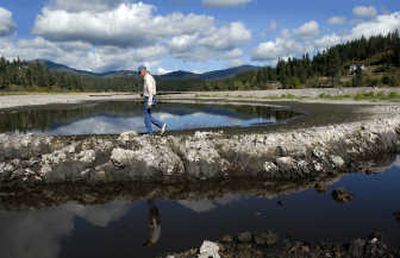Owner returns land to its natural state

HAUSER LAKE – In 1995, Ray Laboure bought 27 acres of Hauser Lake watershed with a vision to transform it to its original state – a wildlife habitat.
Today, the transformation of 13 1/2 of those acres into ponds is almost complete. Visitors can observe Canada geese, blue herons, ducks and osprey around the new ponds created at the Hauser Wetlands Project on Hauser Lake Road just west of Three Forks Road.
Before the wetlands project began, the area was a flat field. Laboure knew that the watershed played a key role in the health of Hauser Lake.
Wetlands benefits include providing habitat for fish and wildlife, including threatened and endangered species; improving water quality by filtering sediments and chemicals; reducing flooding; recharging groundwater; and protecting biological diversity.
In order to develop and improve the watershed the Natural Resource Conservation Service, formerly the Soil Conservation Service, was contacted.
Once a permanent easement was granted and funds were secured from the 2002 Farm Bill, the conservation service was able to complete necessary engineering and construction through the Wetland Reserve Program. That’s a voluntary program offering landowners the opportunity to protect, restore, and enhance wetlands on their property and establish long-term conservation and wildlife practices and protection.
Mark Addy, district conservationist with the conservation service, and Kim Erk, engineer technician, were involved in the five-year project.
“The ponds were excavated and built with water depth levels that will promote diversity in vegetation and wildlife,” says Addy.
Laboure contacted David Liptich, a regional wildlife habitat biologist with Idaho Fish and Game, in 2001. After looking over the site, Liptich decided the Hauser Wetlands Project fit the criteria for the Wildlife Habitat Incentives Program, which provides to conservation-minded landowners technical assistance and cost-share assistance to improve fish and wildlife habitats.
“The habitat will be more versatile and will also promote a brood-rearing habitat so nests will be seen around the ponds,” says Liptich.
Liptich said the next step is to revegetate the site. By November, grass seed will be spread and hydromulching will be complete. In spring, shrubs will be planted and the whole project will be completed by next July.
“This is the best habitat improvement project I have been involved in,” said Liptich, a 21-year Idaho Fish and Game employee. “The partnership between federal, state, and private ownership has been a win-win situation.”
“Ray Laboure took his own money, bought the watershed, and transformed it back to its original state,” said Hauser Lake Watershed Coalition committee member Jim Wallace. “He loves Mother Nature, and he loves this lake.”